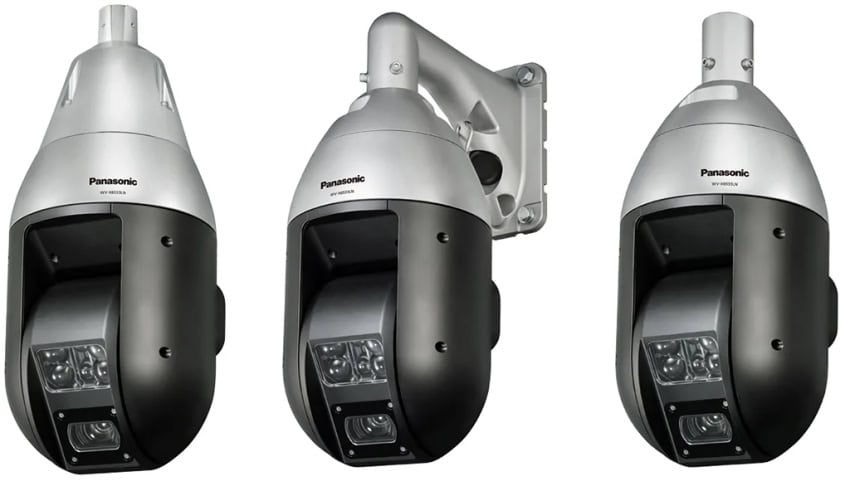DUBAI – Panasonic Marketing Middle East and Africa (PMMAF) has announced an expanded security product and solution portfolio aimed at addressing the region’s growing demand for intelligent security and surveillance systems.
Heading the new launches is the WV-X6533LN, a Full-HD 1080p iA PTZ Network Camera with long-range infrared.
The Japanese manufacturer is also releasing brand new H.265 Series Multi-Sensor Network Cameras that feature four repositionable lenses, each with 4K image sensors. Completing the brand’s enhanced security offerings is a more powerful and more intuitive FacePro WV-ASF950, which now comes with the Unregistered Face Detection feature. FacePro is Panasonic’s an ultra-powerful Facial Recognition Software that uses Deep Learning algorithm to identify faces otherwise difficult to recognize using conventional video surveillance technology.
The Middle East’s security market has seen a great deal of growth in recent years with future prospects seen to remain on an upward trend. Based on a report by 6WResearch, the regional market for commercial and cyber security, fire protection, smart home solutions, and drones is projected to grow to US$16.4 billion in 2024. A big chunk of this figure is attributed to Commercial Security, comprising video surveillance, access control, and intrusion detection, which is seen to register a US$7.4 billion growth by 2024.
Yoshiki Kogane – Manager, System Solutions & Communications, Panasonic, said, “The strong focus of the Middle Eastern governments on socioeconomic reform programs call for vast infrastructure and technological developments. Panasonic, with our long heritage and continuing commitment to breakthrough innovations, is well positioned to supply the region’s growing needs for sophisticated and reliable security and surveillance solutions.”
WV-X6533LN – IP Camera / Network Camera
The WV-X6533LN, part of the i-PRO EXTREME series, can capture high quality images automatically, even in very challenging and fast-changing surveillance environments. Its heavy-duty pan/tilt gear mechanism offer a long life cycle and are designed to minimise blind spots at areas where a wide area needs to be monitored.
The Intelligent Auto (iA) PTZ Dome camera also offer Clear Sight Coating, while its built-in long-distance IR LED produces a clear monochrome image at 0 lux conditions up to 350 m. With an outstanding Intelligent Zoom Stabilization feature, the WV-X6533LN allows increased visibility in blurred conditions. Intelligent Auto, meanwhile, automatically adjusts key camera settings in real-time when monitoring challenging scenes, reducing motion blur of moving objects. With its H.265 Smart Coding technology, the camera intelligently reduces bandwidth efficiency for longer recording and less storage.
i-PRO Extreme H.265 Multi-Sensor Cameras: WV-X8570N and WV-S8530N
Panasonic is pushing the limits of technology in video surveillance with the addition of two new i-PRO Extreme Multi-Sensor cameras. The WV-X8570N delivers 4 x True 4K high resolution (33MP) 3840×2160 15fps image quality, while the WV-S8530N is capable of a 4 x Full HD (8MP) 1600×1200 / 1920×1080 30fps image output. Able to capture evidence under the most challenging of conditions, these cameras are built with four repositionable lenses, as well as offer wide range tilt angle adjustment mechanism that allows for both a 270-degree view and a 360-degree view, thus minimizing blind spots and ensuring greater viewing flexibility.
Both cameras also feature iA (intelligent Auto) support and ClearSight Coating, as well as offer best-in-class environmental durability (IP66, IK10 and Dehumidification). Additionally, they are optimized for nighttime applications, delivering outstanding low light performance in true colour with Super Dynamic 108dB, for backlit situations and shadows. An efficient H.265 compression provides longer recording yet requires less storage resources, while the Smart Coding feature detects movement within an image and compresses areas with little motion to reduce transmitted data while maintaining the quality of the image.
Panasonic Facial Recognition System: FacePro WV-ASF950
The Panasonic FacePro WV-ASF950, using a Deep Learning algorithm, can identify faces that are difficult to recognize with conventional technologies, including faces at an angle of up to 45 degrees to the left or right or 30 degrees up or down, and those partially hidden by sunglasses. Maintaining an accuracy rate of 90% when detecting faces partially hidden by sunglasses or face masks, FacePro WV-ASF950 can also recognize faces taken from up to ten-year-old passport images.
The latest FacePro version packs even more value with a new feature called Unregistered Face Detection. This enhancement offers real-time detection of suspicious people who are not registered in the system. It is especially ideal in establishments with restricted areas, to which access is limited only to authorized personnel, such as laboratories in a manufacturing facility, registrar’s office in academic settings and more. With the Unregistered Face Detection function in use, the system is able to detect people other than registered faces with high accuracy, and subsequently issues a notification/alarm when the outsider is detected attempting access to the restricted area.
Additionally, FacePro features the iA (intelligent Auto) mode that automatically adjusts settings for the camera to shoot optimal images best suited for facial recognition. When it is used with Panasonic’s i-PRO EXTREME series network cameras installed with the “Best Shot License Key” that comes bundled with the software, only the “Best Shots” will be sent to the server for facial recognition.
The combination of Panasonic core devices and the face recognition software maximizes the performance of the software’s core engine to achieve high-precision recognition. Furthermore, using this software with cameras equipped with the iA function enables image analysis to be performed on the camera instead of the server to send only the best images to the server. This will result in reducing server and network loads, which leads to overall system cost reductions.













